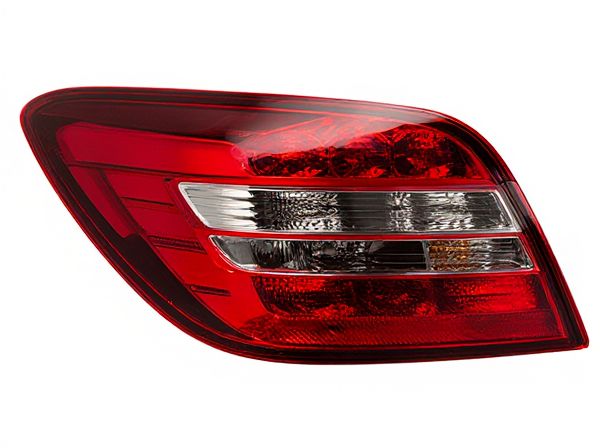
Photo illustration: Aftermarket Taillight vs Factory Taillight
Aftermarket taillights offer a wider variety of styles and often improved performance features compared to factory taillights, allowing you to customize your vehicle's appearance. Factory taillights provide guaranteed fitment, reliability, and compliance with safety standards, ensuring consistent quality. Choosing between the two depends on your preference for customization versus original equipment manufacturer (OEM) assurance.
Table of Comparison
| Feature | Aftermarket Taillight | Factory Taillight |
|---|---|---|
| Cost | Lower price, budget-friendly options | Higher price, OEM quality |
| Quality | Variable quality, depends on brand | Consistent high quality, meets manufacturer standards |
| Fitment | May require modification for perfect fit | Exact fit, designed for specific car model |
| Warranty | Limited warranty, varies by seller | Comprehensive warranty from manufacturer |
| Design | More variety, custom styles available | Standard design, matches original car look |
| Durability | Generally less durable, depends on material | High durability, tested for long-term use |
| Safety | May lack full compliance with regulations | Fully compliant with safety standards |
Introduction to Taillights: Aftermarket vs Factory
Factory taillights are designed and tested by the original vehicle manufacturer to meet strict safety and quality standards, ensuring seamless compatibility and durability. Aftermarket taillights offer a wide range of styles and features, often at a lower price point, but quality and fitment can vary significantly between brands. Choosing between aftermarket and factory taillights requires considering factors such as legal compliance, design preferences, and long-term performance.
Design Differences: Aesthetic Appeal and Customization
Aftermarket taillights offer a wide range of design options, including smoked lenses, LED patterns, and unique shapes that enhance a vehicle's aesthetic appeal beyond standard factory taillights. Factory taillights prioritize uniformity and regulatory compliance, often featuring conventional designs that maintain the original look of the vehicle. Customization with aftermarket options allows car enthusiasts to personalize the rear-end appearance, providing a distinct style that factory taillights typically cannot match.
Build Quality and Material Comparison
Aftermarket taillights often use lower-grade plastics and less precise manufacturing techniques compared to factory taillights, resulting in reduced durability and fitment issues. Factory taillights are typically made with OEM-approved materials and undergo rigorous quality control to ensure optimal weather resistance and impact strength. The superior build quality of factory taillights generally provides better longevity and consistent performance under various driving conditions.
Performance and Brightness Analysis
Aftermarket taillights often feature advanced LED technology that provides higher brightness and improved visibility compared to factory taillights, enhancing safety during nighttime driving. Factory taillights are designed to meet original equipment manufacturer (OEM) standards, ensuring consistent performance and compatibility with the vehicle's electrical system. Performance analysis reveals that high-quality aftermarket options can offer faster response times and longer lifespan but may vary widely in build quality and illumination uniformity.
Installation Process and Compatibility
Aftermarket taillights often require additional modifications during installation due to differences in mounting points and wiring harnesses compared to factory taillights, which are designed for direct fit. Compatibility varies significantly, as factory taillights ensure seamless integration with vehicle systems, including CAN bus and safety sensors, while aftermarket options may need adapters or resistors to prevent error codes. Choosing aftermarket taillights demands careful verification of fitment specifications and potential extra components to achieve a smooth installation process.
Cost Comparison: Upfront and Long-Term Value
Aftermarket taillights typically offer a lower upfront cost compared to factory taillights, making them an attractive option for budget-conscious buyers. However, factory taillights often provide superior durability and warranty coverage, potentially reducing long-term maintenance expenses. Evaluating total cost of ownership involves balancing initial savings with factors such as build quality, fitment precision, and expected lifespan.
Safety Standards and Compliance
Aftermarket taillights often vary widely in safety standards and compliance, with some meeting DOT (Department of Transportation) and SAE (Society of Automotive Engineers) certifications, while others may not adhere to these critical regulations. Factory taillights are designed and tested to meet stringent federal safety standards, ensuring consistent brightness, durability, and visibility in all conditions. Choosing factory taillights guarantees compliance with legal requirements and optimizes vehicle safety, reducing the risk of accidents related to lighting failure or inadequate illumination.
Warranty, Support, and Reliability
Factory taillights typically come with a comprehensive manufacturer's warranty that ensures coverage for defects and malfunctions, offering reliable customer support through authorized dealers and service centers. Aftermarket taillights may offer limited warranties, often varying by brand, and customer support can be inconsistent, affecting reliability and long-term satisfaction. Choosing factory taillights generally provides better assurance of quality, backed by rigorous testing and consistent support infrastructure.
Common Issues and Troubleshooting
Aftermarket taillights often face issues such as poor fitment, inconsistent brightness, and compatibility problems with vehicle wiring, which can lead to malfunctioning brake lights or turn signals. Factory taillights generally provide reliable performance due to precise engineering and seamless integration with the vehicle's electrical system, minimizing troubleshooting needs. Common troubleshooting steps for aftermarket lights include checking grounding points, verifying voltage levels, and ensuring proper connector compatibility to resolve flickering or non-functioning lights.
Conclusion: Which Taillight Option Is Best for You?
Choosing between aftermarket taillights and factory taillights depends on your priorities such as budget, lighting performance, and style preferences. Factory taillights ensure perfect fitment, regulatory compliance, and consistent quality aligned with your vehicle's specifications, while aftermarket options offer a wider range of designs and features often at a lower cost. For those valuing OEM reliability and warranty coverage, factory taillights are best, whereas customization enthusiasts seeking unique aesthetics and potentially enhanced functionality may prefer aftermarket alternatives.
 caratoz.com
caratoz.com